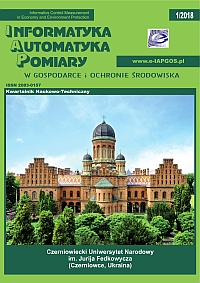DEAD TIME MEASUREMENT BY TWO-SOURCE METHOD – OPTIMIZATION OF MEASUREMENT TIME DIVISION
Article Sidebar
Open full text
Issue Vol. 8 No. 1 (2018)
-
DETERMINATION OF THE EFFICIENCY FACTORS OF THE ABSORPTION AND SCATTERING OF NICKEL NANOPARTICLES
Oleksandr Machulianskyi, Bohdan Babych, Viktor Machulianskyi4-7
-
CONTROL MODEL OF DATA STREAM TRANSMITTED OVER A NETWORK BASED ON PROXYING TECHNOLOGY
Olesia Barkovska, Vitaliy Serdechnyi8-11
-
INVESTIGATION OF THE MEMRISTOR NONLINEAR PROPERTIES
Sviatoslav Khrapko, Volodymyr Rusyn, Leonid Politansky12-15
-
IMITATION MODELING OF THE ROUTING PROCESS BASED ON FUZZY LOGIC
Ivan Lesovoy, Genagij Pylypenko16-19
-
INVARIANT PIEZORESONANCE DEVICES BASED ON ADAPTIVE MULTIFREQUENCY SYSTEMS WITH A PREDICTIVE STANDARD
Sergey Pidchenko, Alla Taranchuk20-23
-
DEVELOPMENT AND RESEARCH OF CRYPTOGRAPHIC HASH FUNCTIONS BASED ON TWO-DIMENSIONAL CELLULAR AUTOMATA
Yuliya Tanasyuk, Sergey Ostapov24-27
-
GENERALIZED APPROACH TO HURST EXPONENT ESTIMATING BY TIME SERIES
Lyudmyla Kirichenko, Tamara Radivilova, Vitalii Bulakh28-31
-
SPECTRAL SENSITIVITY OF HUMAN VISION TO THE LIGHT PULSES
Volodymyr Brailovsky, Ivan Pyslar, Magharyta Rozhdestvenska, Magdalena Michalska32-35
-
ORGANIZATION OF IMPLEMENTATION OF UBIQUITOUS SENSOR NETWORKS
Sergey Toliupa, Yuriy Kravchenko, Aleksander Trush36-39
-
PECULIARITIES OF THE RADIO SIGNALS AND HINDRANCES IN THE NAVIGATION SYSTEM OF THE REMOTE-PILOTED VEHICLES
Mykola Mykyjchuk, Volodymyr Markiv40-43
-
DISTORTIONLESS SIGNALS TRANSFER THROUGH A WIRE MEDIA METASTRUCTURE
Dmytro Vovchuk, Serhii Haliuk, Leonid Politanskyy44-47
-
THE USE OF ARTIFICIAL INTELLIGENCE IN AUTOMATED IN-HOUSE LOGISTICS CENTRES
Tomasz Rymarczyk, Grzegorz Kłosowski48-51
-
USING MICROSERVICES ARCHITECTURE AS ANALYTICAL SYSTEM FOR ELECTRICAL IMPEDANCE TOMOGRAPHY IMAGING
Tomasz Cieplak, Tomasz Rymarczyk, Grzegorz Kłosowski52-55
-
OPTIMIZATION OF DATA PROCESSING FOR REQUESTING OBSERVATION SYSTEMS
Iryna V. Svyd, Andrij I. Obod, Oleksandr S. Maltsev, Daria B. Pavlova, Bridel V. Mongo56-59
-
METHODS OF PRODUCING APODIZED FIBER BRAGG GRATINGS AND EXAMPLES OF THEIR APPLICATIONS
Łukasz Zychowicz, Jacek Klimek, Piotr Kisała60-63
-
DEAD TIME MEASUREMENT BY TWO-SOURCE METHOD – OPTIMIZATION OF MEASUREMENT TIME DIVISION
Grzegorz Domański, Bogumił Konarzewski, Robert Kurjata, Krzysztof Zaremba, Janusz Marzec, Michał Dziewiecki, Marcin Ziembicki, Andrzej Rychter, Waldemar Smolik, Roman Szabatin, Piotr Brzeski64-66
-
ANALYSIS OF THE BENDING STRAIN INFLUENCE ON THE CURRENT- -VOLTAGE CHARACTERISTICS OF HTC SUPERCONDUCTING TAPES
Jacek Sosnowski67-70
-
DETERMINATION OF R = F(T) CHARACTERISTICS OF THE FIRST AND SECOND GENERATION SUPERCONDUCTING TAPES
Rafał Kwoka, Janusz Kozak, Michał Majka71-74
Archives
-
Vol. 10 No. 4
2020-12-20 16
-
Vol. 10 No. 3
2020-09-30 22
-
Vol. 10 No. 2
2020-06-30 16
-
Vol. 10 No. 1
2020-03-30 19
-
Vol. 9 No. 4
2019-12-16 20
-
Vol. 9 No. 3
2019-09-26 20
-
Vol. 9 No. 2
2019-06-21 16
-
Vol. 9 No. 1
2019-03-03 13
-
Vol. 8 No. 4
2018-12-16 16
-
Vol. 8 No. 3
2018-09-25 16
-
Vol. 8 No. 2
2018-05-30 18
-
Vol. 8 No. 1
2018-02-28 18
-
Vol. 7 No. 4
2017-12-21 23
-
Vol. 7 No. 3
2017-09-30 24
-
Vol. 7 No. 2
2017-06-30 27
-
Vol. 7 No. 1
2017-03-03 33
-
Vol. 6 No. 4
2016-12-22 16
-
Vol. 6 No. 3
2016-08-08 18
-
Vol. 6 No. 2
2016-05-10 16
-
Vol. 6 No. 1
2016-02-04 16
Main Article Content
DOI
Authors
Abstract
The article presents the analysis of the dead time measurement using two sources for a non-paralyzable detector. It determined the optimum division of count rate measurement time between both source measurement and a single source one. Results of the work can be used to optimize dead time measurement for systems which count photons or particles.
Keywords:
References
Knoll G.F.: Radiation Detection and Measurement (4th ed.). Willey, 2010.
Meeks C., Siegel P.B.: Dead time correction via the time series. Am. J. Phys. 76 (6), 2008, 589–590 [DOI: 10.1119/1.2870432].
Myers R.T.: Dead Time of a Geiger-Mueller Tube by the Double-Source Method. Journal of Chemical Education 33(8), 1956, 395–396 [DOI: 10.1021/ed033p395].
Article Details
Abstract views: 375
License

This work is licensed under a Creative Commons Attribution-ShareAlike 4.0 International License.






